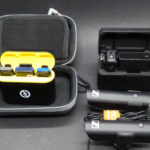f you don’t have a grand to spare to get the best of the best, what’s a budding voice over / podcaster to do?
There is no question the gold plated standard – as is the current buzz phrase – for this sort of mic is the Sennheiser MKH416-P478U3 pictured above (and no, I don’t know who invents model numbers either), but at AUD$1000 and a bit, it is beyond the range of all but the most discerning, or perhaps a pro studio.
I have come across three options that might fill your needs. One is from Elgato (which have been around forever) and the others from Hong Kong based Thronmax.
All three are connected to your PC via USB-C / A making setup nice and easy with no specialist drivers necessary and all can either be desk stand mounted or attached to a boom arm.
Elgato Wave:3
 The Elgato Wave:3 is a condenser style mic making it ideal for voice over and podcasting. Being a condenser means it picks up sound mainly around the front and sides, and less in the back and the Elgato Wave:3 is capable of 24 bit / 96kHz recording giving very high quality audio captures.
The Elgato Wave:3 is a condenser style mic making it ideal for voice over and podcasting. Being a condenser means it picks up sound mainly around the front and sides, and less in the back and the Elgato Wave:3 is capable of 24 bit / 96kHz recording giving very high quality audio captures.
24 bit allows more flexibility in post editing and noise reduction.
A dial on the front of the Elgato Wave:3 clicks in so you can cycle through its different volume options and the rear has the USB-C port and 3.5mm headphone jack for monitoring. On the top is a touch-sensitive sensor for muting. Just give it a tap it and the LED ring around the dial will turn red to show it’s now muted.
Thronmax MDRILL Zero Plus
 The Thronmax MDRILL Zero Plus is a bit of an oddity in USB mics in that it is both a condenser mic (great for close up work such as voice overs) and omni-directional (for using in a conference situation say where the mic is placed on a table between participants).
The Thronmax MDRILL Zero Plus is a bit of an oddity in USB mics in that it is both a condenser mic (great for close up work such as voice overs) and omni-directional (for using in a conference situation say where the mic is placed on a table between participants).
You flick between the two modes by a simple turn of a knob.
In the former guise this is a good mic, but in the latter, it just didn’t work for me. The condenser mode seemed to actually work better than the omni mode did which is downright weird. I thought this might just be me, or this particular mic, but a check of other reviews confirmed my suspicions!
Which is a shame because everything else about this mic is stuff to like. You have the ability monitor audio via plugging a set of headphones in, no drivers are needed, it operates at 96kHz and it comes with a decent length of braided USB cable. You may – or not – also like the LED lighting.
The only caveat of the condenser mode is that you do need to be very close to the mic otherwise you are at a risk of picking up background noise such as keyboard clicks. To aid in this, I also used the Thronmax Zoom Boom stand, taking the mic out of the desk stand and thus off the desk.
Thronmax MDRILL One Pro
 The Thronmax MDRILL One Pro became my mic of choice after testing all three for the purposes I had in mind.
The Thronmax MDRILL One Pro became my mic of choice after testing all three for the purposes I had in mind.
Like its brethren, it is USB based, but unlike the Zero Plus which has two modes, one of which as I mentioned is not that good in my opinion, the MDRILL One has four – cardoid, stereo, omnidirectional and bi-directional.
The front of the mic has a control panel with a small screen and a couple of buttons. The lower of the two control which recording mode you want and an icon is displayed so you know what is currently selected. The upper button is simply a mute (here I do prefer the Elgato Wave:3 method I admit).
The screen displays the current gain and headphone volume (yes there is a headphone socket) and these settings are saved internally when the mic is unplugged.
One thing both Thronmax mics share is a technology the company calls Vertigain. The faces of the mic unlike “traditional” mics does not contain a mesh system but instead is a vertical grill design. The theory is that sound waves move vertically through the mic instead of being scattered. This is said to allow the sound to pass through the grille more evenly.
Conclusion
I chose the Thronmax MDRILL One for my purposes not because of the features set – which is excellent – but for the audio quality compared to the other two. The Elgato Wave: 3 was a second choice, but I personally felt in my environment – and I admit this has a lot to do with it – it sounded muddy and had a slight reverb to it.
The Thromdrill MDRILL Zero Plus is just not in the same league as the other two I am afraid.
But of course, audio is very subjective as is most things when it comes to hardware (and software) choices. One person’s Holden is another’s Toyota, or something like that. So I would always, if possible, try and do a test recording of each you are looking at and then compare.
Prices (AUD$):
- Elgato Wave:3 $229.00
- Thromdrill MDRILL Zero Plus $149.00
- Thronmax MDRILL One $239.00



